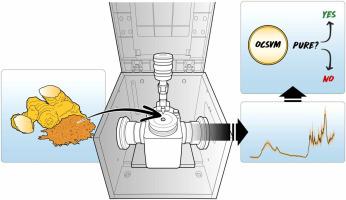Vibrational Spectroscopy ( IF 2.5 ) Pub Date : 2023-12-23 , DOI: 10.1016/j.vibspec.2023.103646 Joel I. Ballesteros , Len Herald V. Lim , Rheo B. Lamorena

|
Once turmeric has been ground into powder, it is difficult to tell visually if it has been tampered with. In this study, ATR-FTIR spectroscopy was used in tandem with one-class support vector machine (OCSVM) to detect adulteration in turmeric powder. The OCSVM models were trained using 42 pure turmeric powder samples, optimized using 30 pure turmeric powder samples, and subsequently evaluated by classifying 30 pure and 120 adulterated (cornstarch, Metanil Yellow, Orange II, and Sudan I) samples. Preprocessing methods, such as Savitzky-Golay (SG)-derivatives, standard normal variate (SNV), and multiplicative scatter correction (MSC), were used individually and in combination to obtain the best-performing model. Models were assessed by comparing the sensitivity, specificity, and efficiency values and compared with one-class soft independent modeling of class analogy (OCSIMCA). The best performing OCSVM model (sensitivity = 1.00, specificity = 0.89) was obtained by first conducting an MSC on the raw data followed by SG-2nd derivative transformation. It also has an efficiency value of 0.94, which was 0.14 higher than when data preprocessing was not done. Compared to the results of OCSIMCA, the OCSVM model gave a higher efficiency value and can detect lower levels of cornstarch adulteration. Also, the results showed that inclusion of data preprocessing can lead to a better classification model. With the obtained evaluation parameter values, ATR-spectroscopy coupled with OCSVM demonstrated its potential for screening turmeric powder products.
中文翻译:

ATR-FTIR光谱结合一类支持向量机筛选姜黄粉的可行性
一旦姜黄被磨成粉末,就很难通过肉眼判断它是否被篡改。在本研究中,ATR-FTIR 光谱与一类支持向量机 (OCSVM) 串联使用来检测姜黄粉中的掺假。OCSVM 模型使用 42 个纯姜黄粉样品进行训练,使用 30 个纯姜黄粉样品进行优化,随后通过对 30 个纯姜黄粉样品和 120 个掺假样品(玉米淀粉、Metanil Yellow、Orange II 和苏丹 I)进行分类进行评估。单独或组合使用 Savitzky-Golay (SG) 导数、标准正态变量 (SNV) 和乘性散点校正 (MSC) 等预处理方法来获得性能最佳的模型。通过比较敏感性、特异性和效率值并与类比的一类软独立建模 (OCSIMCA) 进行比较来评估模型。性能最佳的 OCSVM 模型(灵敏度 = 1.00,特异性 = 0.89)是通过首先对原始数据进行 MSC,然后进行 SG-2 阶导数转换而获得的。它的效率值为0.94,比未进行数据预处理时高0.14。与 OCSIMCA 的结果相比,OCSVM 模型给出了更高的效率值,并且可以检测出较低水平的玉米淀粉掺假。此外,结果表明,包含数据预处理可以产生更好的分类模型。根据获得的评估参数值,ATR 光谱与 OCSVM 结合证明了其筛选姜黄粉产品的潜力。



























 京公网安备 11010802027423号
京公网安备 11010802027423号